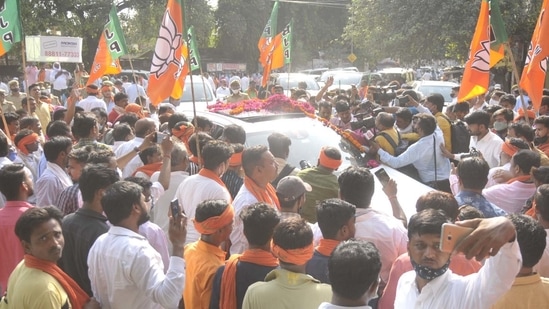The grim world of UP’s district politics
As a ruling party, the BJP’s win in UP local polls isn’t surprising, and reflects the distortions in local politics.
The Bharatiya Janata Party (BJP) has won 67 of the 75 district council presidencies (zilla panchayat adkhyaksh or ZPA) in Uttar Pradesh (UP). While the party is celebrating its win with great gusto, it is important to place it in context.

The results follow the usual patterns of local body elections in the state in which the ruling party virtually sweeps district and block council presidencies. The state machinery gets deployed to its fullest and council members are wooed, often with financial inducements, to swing their vote. They, or even their family members get harassed, or worse, abducted to ensure they vote in a certain way. It is not surprising then that during the 2015 local body polls, the Samajwadi Party (SP) won more than 60 ZPAs and the Bahujan Samaj Party (BSP) won similar numbers in 2010 when it was in power in Lucknow.
What are the political-economy reasons that have sustained this system?
First, it is important to understand the institutional set-up as the current morass flows from it. The panchayati raj system has three layers – village, block and district council. While the ward members at all three levels are directly elected, as is the pradhan/ sarpanch, the block pramukh (BP) and ZPA are elected indirectly, i.e., only council members vote. Political party symbols are not used during local body elections in UP.
The 73rd and 74th constitutional amendments instituted provisions of reservations for lower castes and women. In UP, half the seats at all levels are in the open category, in which anyone can contest. However, each category of reservation has a 33% quota for women. The position nomenclatures, election rules, and reservation proportions differ widely across states. For example, some states have reservations for Muslims, and in some other states, women’s reservation is 50%.
Second, indirect elections of district and block council presidents have created a system in which large numbers, mostly candidates supported by the ruling party, get elected unopposed. In 2021 and 2015, 22 and 38 ZPAs were elected unopposed respectively. Similarly, one-third of 820 block pramukhs in 2015 were also elected unopposed. The proportions may vary, but this trend has persisted in UP‘s local body elections since 1995.
This doesn’t mean there aren’t competitive candidates; rather, it is a function of de facto influence of a ZPA hopeful. For example, the Etawah ZPA is the only seat in 2021 that the SP won unopposed. Anshul Yadav who won this seat for the second time is Mulayam Singh Yadav’s grandnephew and the Etawah ZPA seat has remained with the Yadav family since 1990.
Third, the sheer money and muscle power deployed during these elections is phenomenal. During my doctoral dissertation fieldwork in 2015 (and telephone conversations during this round), it emerged that the expenditure incurred by successful candidates ranged from ₹5-10 crore for a ZPA seat and ₹1-3 crore for a BP seat. In comparative terms, a ZPA candidate often spends more than a Lok Sabha election candidate, and a BP more than a legislative assembly candidate. The expenditure was largely driven by the district council’s annual budget (proportionate rent-seeking possibilities) and the amount the competitor was offering to council members. Winning these elections is important for the politically ambitious as a ZPA and BP become claimants to party nominations for the Lok Sabha and assembly elections respectively.
Fourth, the main contestants for the council presidency are mostly relatives of sitting Members of Parliament (MP), Members of Legislative Assembly (MLA), and ministers, and figures from the ruling party in the state. In fact, as soon as a change in the ruling regime in the state capital takes place, successful no-confidence motions are brought against many sitting ZPAs and BPs.
Within months of the BJP’s win in 2017, the presidents in one in every four district and block councils got changed. For example, the wife of late Vinod Singh (a minister in Akhilesh Yadav’s cabinet) was elected president of the Gonda district council in 2015 and his two nephews became block pramukhs. With the change of guard in 2017, they had to resign from their posts, and the wife of BJP MP Brajbhusan Singh was elected ZPA and his two relatives became block pramukhs. Similar proportions of leadership positions changed when the BSP and the SP were elected in 2007 and 2012 respectively.
Fifth, in many cases, especially when the seat gets reserved for a caste which is not the same as a senior politician interested in the position, the politicians in question get their loyalists or employees elected to these posts. While it helps to share power with politically ambitious family members, there is a deeper political economy reason that helps in the local entrenchment of political power.
During my fieldwork, I found that most mid-level politicians in rural India own businesses such as brick kilns, petrol pumps, transport, or sand mining. A large portion of district council budgets gets spent on construction-related activities (building or repair of roads, government offices, schools, bridges, among others). Connect the two dots. The tender is issued and awarded to the machine owned by the same network.
This is a power-begets-power story in rural India. A decentralised governance system has indeed opened up many spaces and brought marginalised groups into power hierarchies, yet it is also becoming an enabler of political entrenchment.
All Access.
One Subscription.
Get 360° coverage—from daily headlines
to 100 year archives.



HT App & Website






